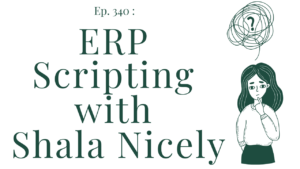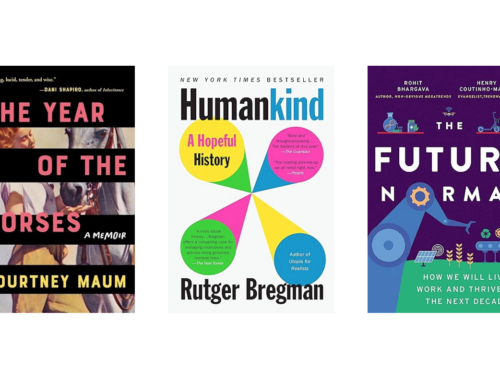 Exposure and response prevention (ERP) scripting (also known as imaginal exposure) is one of my favorite tools to use against OCD. I’ve written extensively about scripting in “Interrupt OCD’s Rituals with May or May Not” and the follow up “Q&A” post, so in this post I’m going to cover how I use scripts in a bit more detail.
Exposure and response prevention (ERP) scripting (also known as imaginal exposure) is one of my favorite tools to use against OCD. I’ve written extensively about scripting in “Interrupt OCD’s Rituals with May or May Not” and the follow up “Q&A” post, so in this post I’m going to cover how I use scripts in a bit more detail.
You can also listen to Kimberley Quinlan, LMFT, and me discussing ERP scripting on episode 340 of Your Anxiety Toolkit podcast below.
The core for “what if?”: may or may not statements
When there’s a feared consequence that OCD is threatening, the core part of any script I use tends to be a “may or may not” (MOMN) statement. The point of this statement is to 1) keep the intrusive thought present 2) without mentally ritualizing. An example for the obsession “What if my partner isn’t the right person for me?” could be “I may or may not be in the right relationship.”
Now some therapists and people with OCD use worse-case scenario wording for scripts, such as “My partner is not the right person for me,” and that’s fine, too. However, I don’t tend to use worst-case scenario scripting for myself. I found in my own recovery that I believed the worst-case scenario statement, and this turned into its own form of subtle compulsion where I was acting depressed because I believed OCD (i.e. acting as if what the OCD said was true), which kept me stuck in the compulsive cycle.
The core for just right OCD: “Yay icky feeling!”
There’s also just right OCD, where OCD doesn’t like something because it’s not “right.” A relationship OCD (ROCD) just right obsession might be a focus on some imperfection the partner has, such as “I just can’t stand the way his hair always sticks up in the back like he’s just gotten out of bed.” The just right (JR) ERP script I would use for this would go something like this, “OCD, did you see how much his hair is sticking up today? I’m so glad it looks like that because it bothers you so much, OCD, and I love bothering you! The more I bother you, the better I get, OCD, so I hope his hair always looks like that! Yay icky feeling! Bring it on!” Basically, I am rolling around in the just-wrongness like a happy pig in a mud puddle, going toward the icky feeling instead of trying to fix it with compulsive physical or mental behaviors.
I can also combine MOMN and JR scripts, such as “He MOMN be the right person for me, but if he is, boy I hope his hair always looks like that, OCD!”
The fun: swearing at OCD
 Several years ago I wrote a blog called “The Hidden Power of Swearing at Your OCD,” and my fondness for swearing at OCD since that time has only increased. If you like to swear, swear at OCD! Use your favorite swear words, get creative, see how many you can put in one sentence! Channel any anger you have towards OCD into empowering, swearing-filled statements about how you are not listening to OCD anymore because you are reclaiming your life! And if you’d like fun examples, check out my swearing blog.
Several years ago I wrote a blog called “The Hidden Power of Swearing at Your OCD,” and my fondness for swearing at OCD since that time has only increased. If you like to swear, swear at OCD! Use your favorite swear words, get creative, see how many you can put in one sentence! Channel any anger you have towards OCD into empowering, swearing-filled statements about how you are not listening to OCD anymore because you are reclaiming your life! And if you’d like fun examples, check out my swearing blog.
The nitty gritty: the what, where, why, when and how of ERP scripting for OCD
What?
- Most effective when used with in-vivo exposure: I’ve found that ERP scripting for OCD, or imaginal exposure, is most effective when used in combination with in-vivo exposure, i.e. doing something that I want to do that also happens to scare OCD. For the relationship OCD scenario where my OCD wonders if my partner is right for me, the in vivo exposure might be planning a really fun date night that the OCD doesn’t think is a good idea because gosh, if he’s not the right person, I shouldn’t be spending a lot of time, energy, or emotion on the relationship, right? Wrong! In vivo exposure helps me go toward what I really want, which in this case is the relationship, and then I can use the anxiety that creates to beat OCD. I would then use the ERP scripting (either MOMN, JR, or a combination) to keep myself from doing mental rituals before, during, and/or after the in-vivo ERP.
- General-purpose response prevention: ERP scripting can also be used to reduce ruminating that might be going on in the background whether or not I’m doing in-vivo exposures.
Where?
- Location: I do the scripts in the shower or really anywhere in my house or while I’m out and about with no one around; however, I do NOT do them while driving! Why? Because if I get anxious enough, I can develop tunnel vision as a part of the fight or flight response, and then I lose peripheral vision, and I need peripheral vision to see what’s around me while I’m driving.
Why?
- Purpose is to fan the flames of anxiety: The purpose of ERP scripting is to face the intrusive thoughts and/or the not-just-rightness and thereby raise anxiety. That’s how we get better, by going toward the scary or icky thoughts instead of running away from them. Over time as I do scripts and my brain starts to accept the uncertainty about whatever it is it’s worried about, my anxiety normally starts to come down, but that is not the point of the exercise. The point is to face the fear and to be anxious on purpose! If I do scripts to lower my anxiety, that is using scripting as a compulsion and will just make OCD worse.
When?
 Proactive and reactive: I do them proactively (bringing up the scary content on purpose) and reactively (when the intrusive thoughts bother me). I’ve found it takes both proactive and reactive to make scripts most effective.
Proactive and reactive: I do them proactively (bringing up the scary content on purpose) and reactively (when the intrusive thoughts bother me). I’ve found it takes both proactive and reactive to make scripts most effective.- Frequency: I do them as often as it takes: once a day, twice a day, 3, 4, 5 times a day…again, whatever it takes. OCD is pretty relentless about trying to get me to do mental rituals, so I try to be equally if not more relentless with my scripts.
- Length: I do them for as long as it takes. So I’m not just saying the MOMN or JR ERP statement once or twice and moving on with my day, as that almost never works for me. I might be saying my scripts for 5 mins, 10 mins, 30 mins, 45 mins, whatever it takes for my brain:
- to start accepting the uncertainty inherent in the situation,
- to get bored with the content, and
- to realize I don’t need to answer that “what if?” question (because it’s unanswerable), and/or
- to realize that I don’t have any control over the not just right thing that OCD doesn’t like and that I can tolerate the feelings it creates.
Typically when all this happens my anxiety starts to go down, and I’ll try to see if I can get the anxiety up again (as that helps my ERP to be more effective), and then it will start to go down again, and then I’ll try to push it up again, and I’ll do that several times until I feel like my brain is really learning that all the OCD content is simply a lot of uncertainty over which it has no control. There have been times when I’ve had to leave a scripting exercise when I’m at a high anxiety level, and that’s fine (because according to the theory of inhibitory learning, anxiety levels do not need to decrease for ERP to work), but I need to be mindful to not ruminate afterwards, as sometimes I can be more tempted to do mental rituals if my anxiety level is high.
How?
- Out loud: I do ERP scripting for OCD out loud if at all possible. Otherwise, it’s easy for the scripts to just become part of the ruminating. If it’s not possible, I do my best to do them in my head, or I excuse myself and go somewhere I can do them out loud for a little while and then come back to what I was doing. I’ve also found I can mumble scripts in public if I happen to be wearing a mask and no one can tell what I’m doing or hear what I’m saying.
- Shoulders Back!: I like to do scripting while standing in a power pose with my Shoulders Back! That makes me feel equally if not more powerful that my OCD does in the moment that I’m facing off with it. I also try to say the statements powerfully and include swearing at the OCD, as I mention above, so that I’m talking back to OCD with attitude that’s as or more sassy than OCD is being to me.
- Focus: I start out saying a lot of different MOMN or JR script statements, and as I do them, I am monitoring my anxiety level. If it goes up when I say a particular statement, I focus on that one even more. What I’m trying to do is find the statement that bothers OCD the most and makes me the most anxious, and then say that over and over and over again until my brain accepts the uncertainty of what I’m saying. Then I move on to the next statement that makes my OCD anxious, etc.
- Addressing sneaky mental compulsions: I pay careful attention to whether or not I’m doing any sneaky rumination in the back of my mind while I’m doing my scripts. For instance, saying “I may or may not really love my partner” out loud while at the same time mentally tossing around the thought “but I’d know if I didn’t really love him, right?” which is a form of mental reassurance. To address this, I would interrupt whatever script I’m currently saying to say instead “OCD, I may or may not know if I really love him” and then go back to my script, continuing to incorporate this new MOMN statement as needed, so that I’m not letting sneaky compulsions in my head occur while I’m doing my script out loud. With JR OCD, I’m also making sure I’m not doing any mental compulsions to “fix” the imperfection OCD doesn’t like in my mind, and I’m not making any sort of faces (ick or disgust) or body movements (cringing away) that reinforce OCD’s point of view.
- Equal weight on “may” and “may not”: Sometimes my OCD will try to get me to focus more on one side of the statement or the other, depending on what’s it’s scared of. For the example above about relationship OCD, if my OCD thinks that my partner really isn’t right for me, it might get me to say “He may or may not be the right one for me” and to focus more on the may not side. If I think this is happening, I interrupt my script and say, “OCD, he MAY or MAY NOT be the right one for me,” trying to put equal weight on both alternatives so that I’m not accidentally believing the OCD.
This may sound like a lot to juggle at one time, but I found that the more I practiced scripting, the more second nature all this became.
ERP Scripting on Your Anxiety Toolkit podcast
 Kimberley Quinlan, LMFT, and I recorded an episode about ERP Scripting which you can listen to on her website or on your favorite podcast app. In this episode we discuss:
Kimberley Quinlan, LMFT, and I recorded an episode about ERP Scripting which you can listen to on her website or on your favorite podcast app. In this episode we discuss:
- Why ERP scripting is important for people with OCD who do mental compulsions
- How ERP scripting helps you deal with OCD’s vivid imagination
- How to know if ERP scripting might be helpful for you or not
- How and why physical compulsions can transform into mental compulsions
- A detailed example of how I approach ERP scripting and also try to turn it into a game
- Why I consider ERP scripting both a dynamic process and a competing response to mental compulsions, and one that we’re not aiming to do perfectly
Take back your power!
OCD likes to talk tough and bully us into doing what it says so that it can stay in
charge. Learning to do ERP scripting can help you discover how to use your own voice to take back your power and reclaim your life from OCD!
To learn more about how scripting can be used in day-to-day life, read Chapter 13 of Is Fred in the Refrigerator?: Taming OCD and Reclaiming My Life. Click here to purchase a copy.
Learn more about taming OCD
Sign up for my Shoulders Back! newsletter to receive OCD-taming tips & resources, including notifications of new blog posts, delivered every month to your inbox.
My blogs are not a replacement for therapy, and I encourage all readers who have obsessive compulsive disorder to find a competent ERP therapist. See the IOCDF treatment provider database for a provider near you. And never give up hope, because you can tame OCD and reclaim your life!
Fanning flames pic (c) Can Stock Photo / Choreograph







Leave A Comment